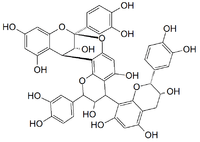Cinnamtannin B1
Cinnamtannin B1 is a condensed tannin found in Cinnamomum verum. It is a type A proanthocyanidin.[1]
 | |
| Identifiers | |
|---|---|
3D model (JSmol) |
|
| ChemSpider | |
PubChem CID |
|
| |
| |
| Properties | |
| C45H36O18 | |
| Molar mass | 864.75 g/mol |
Except where otherwise noted, data are given for materials in their standard state (at 25 °C [77 °F], 100 kPa). | |
| Infobox references | |
Cinnamon could have some pharmacological effects in the treatment of type 2 diabetes mellitus and insulin resistance. The plant material used in the study was mostly from Chinese cinnamon (see Chinese cinnamon's medicinal uses).[2][3] Recent studies in phytochemistry have indicated that cinnamtannin B1 isolated from C. Verum bears possible therapeutic effect on type 2 diabetes,[4] with the exception of the postmenopausal patients studied on Cinnamomum aromaticum.[5]
Cinnamtannin B1 possesses several phenolic hydroxyl groups and is reported to exhibit antioxidant property, antimicrobial activities, and anti-platelet aggregation[6] that may protect damaged tissues in wounds[7]
References
- Anderson; Broadhurst, CL; Polansky, MM; Schmidt, WF; Khan, A; Flanagan, VP; Schoene, NW; Graves, DJ (January 2004). "Isolation and characterization of polyphenol type-A polymers from cinnamon with insulin-like biological activity". J Agric Food Chem. 52 (1): 65–70. doi:10.1021/jf034916b. PMID 14709014.
- Khan A, Safdar M, Ali Khan MM, Khattak KN, Anderson RA (December 2003). "Cinnamon improves glucose and lipids of people with type 2 diabetes". Diabetes Care. 26 (12): 3215–8. doi:10.2337/diacare.26.12.3215. PMID 14633804.
- Verspohl, Eugen J.; Bauer, K; Neddermann, E; et al. (2005). "Antidiabetic effect of Cinnamomum cassia and Cinnamomum zeylanicum In vivo and In vitro". Phytotherapy Research. 19 (3): 203–206. doi:10.1002/ptr.1643. PMID 15934022.
- Taher, Muhammad; et al. "A proanthocyanidin from Cinnamomum zeylanicum stimulates phosphorylation of insulin receptor in 3T3-L1 adipocyties" (PDF). Archived from the original (PDF) on 2008-05-28. Retrieved 2008-05-11.
- Vanschoonbeek, Kristof; et al. "Cinnamon Supplementation Does Not Improve Glycemic Control in Postmenopausal Type 2 Diabetes Patients". Retrieved 2008-05-11.
- López, J. J., Jardín, I., Salido, G. M., & Rosado, J. A. (2008). Cinnamtannin B-1 as an antioxidant and platelet aggregation inhibitor. Life sciences, 82(19), 977-982. doi:10.1016/j.lfs.2008.03.009
- Fujita K, Kuge K, Ozawa N, Sahara S, Zaiki K, Nakaoji K, et al. (2015) Cinnamtannin B-1 Promotes Migration of Mesenchymal Stem Cells and Accelerates Wound Healing in Mice. PLoS ONE 10(12): e0144166. doi:10.1371/journal.pone.0144166